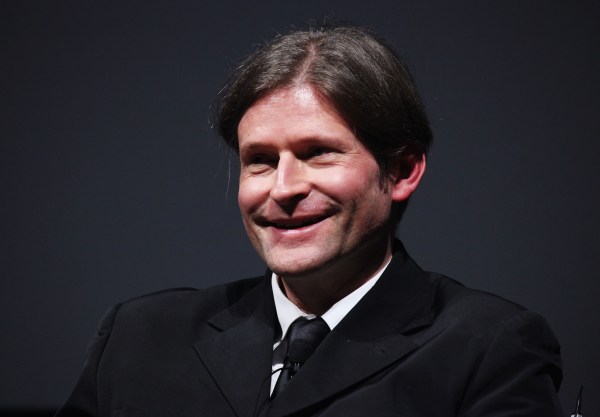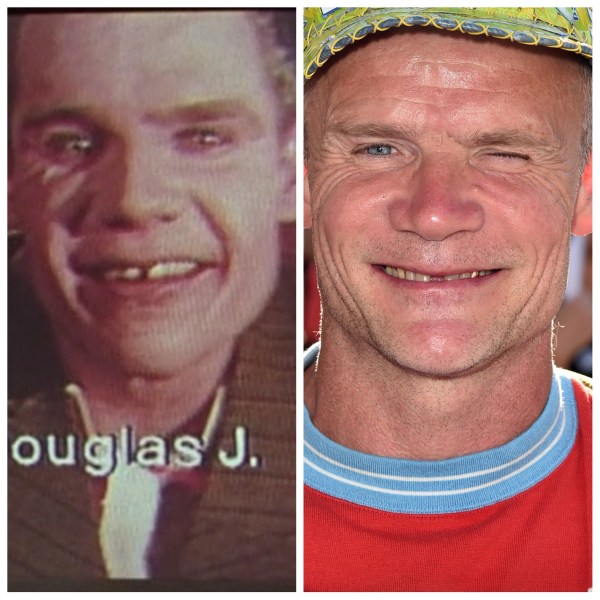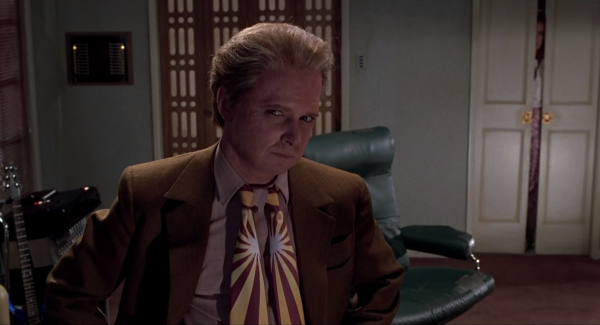This article is part of #Future, a new UPROXX section that covers where the world is headed and how things have changed since 1989. Powered by Toyota.
1988 was a special year. Not just because Poison taught the world about love and loss while answering the age old question “how many cowboys have a sad, sad song?” (answer: every one). The year was also special because three things happened:
1. Bob Gale wrote a script about life in 2015 (amongst other things) that would later be released as Back to the Future Part II in 1989.
2. A young journalist named Nicole Yorkin consulted with prominent futurists, engineers and artists to write an article that predicted life in Los Angeles in 2013 through a fictional account of a family in Granada Hills.
3. An engineer at Northrup Grumman named Jerry Lockenour read Nicole Yorkin’s article about the future of LA, and he liked the article so much that he filed it away.
Back to the Future II would go on to become an international blockbuster (and create a longing for hover boards that would haunt this author for much of his childhood), but Nicole Yorkin’s fantastic article was, sadly, lost to time. Nicole would eventually leave her Pulitzer-prize nominated journalism work for a successful career as a television writer and producer.
By 2015, everyone in the world had seemingly forgotten Nicole’s article. Everyone except Jerry Lockenour.
After a long career at Northrup Grumman, Jerry became a professor at USC. While he was teaching an engineering class about technological innovation, Professor Lockenour knew he had the perfect subject for his students: Nicole Yorkin’s article from 1988. Over the semester, Professor Lockenour and his students studied the predictions in the LA Times article, finding out what the futurists got right, what they got wrong and the reasons behind the hits and misses.
With October 21, 2015 — the date that Marty McFly and Doc Brown travel to in Back to the Future Part II–only one day away, there is no better time to look back on the predictions made by the film and the LA Times article. Luckily, both Nicole Yorkin and Jerry Lockenour agreed to share their expertise about the future that we expected in 1988, and the reality that we have today with Uproxx.
What We Expected — Cars Fueled By Trash
Besides all the hot tub partying/attempted murdering committed by darkest-timeline Biff Tannen, one of the most memorable moments in Back to the Future Part II was Doc Brown powering his flying DeLorean with banana peels and old beer cans.
Despite the amazing advances in automobile technology since 1988 — hybrid engines, and reduced pollution, and even the rumblings of vehicles that drive themselves — we still do not have a car that runs on banana peels and soda cans. But thanks to Toyota, we will soon have something that is almost as good.
Landfills produce a tremendous amount of methane gas, and Toyota has found a way to harvest this otherwise dangerous greenhouse gas and convert it into hydrogen that will soon power their factories and (at least partially) fuel cars like the 2016 Toyota Mirai. With help from Michael J. Fox and Christopher Llyod, Toyota put together a video to introduce the 2016 Mirai and the technology that allows them to turn trash into fuel:
What We Expected — Flying Cars
If there’s anything that defines 2015 for Back to the Future II besides the pounds of distractingly bad old-age makeup, it’s the flying cars. The skies of Hill Valley are absolutely swarmed with sleek and futuristic cars. And also one Jeep. Because the laws of aerodynamics are no match for the law of awesomeness that is a Jeep, especially one with an inexplicable tow rope in the back.
And while Back to the Future II was not entirely accurate about the amount of automobiles in our skies, for a few brave souls with a fundamental ignorance of gravity (and the other, more terrifying laws of physics), flying cars are very real. These flying cars (or “roadable aircraft” depending on who you’re talking to), are still in the experimental phase, and companies like Terrafugia have not yet sold a single vehicle, but Professor Lockenour thinks this will eventually change:
I think you’ll see a few of them [flying cars] within the next ten years. Now, will that be checked off as a good prediction or a bad prediction ten years from now? I think this one company Terrafugia in Massachusetts is very close to having a salable product. And it is, as I understand it, Department of Transportation and FAA certified…they have several hundred orders where people have put down deposits for the production vehicles.
While the LA Times article was not so bold as to predict mass flying transit, the futurists did incorrectly guess that cars that could “go from being a two-seat sports car to a beach buggy — thanks to a plug-in module” as well as “sedans that could convert into a van” would fill the streets of 2015 Los Angeles. Which, to be fair, is one of the few ideas that is just as silly (though infinitely safer) than a flying car.
What We Expected — Rehydrated Pizzas
Despite all the futuristic wonders in Back to the Future II, the one invention that excited this viewer even more than the hover board was the hydrator oven.
Granted, I was a chubby child when I first saw the movie, but even now, as a slightly chubbier and significantly less-mulleted adult, the hydrator oven still seems like a life-altering invention. But unfortunately, in 2015 we are still forced to cook our pizzas with fire. Yes, exactly how the cavemen did it.
Nicole Yorkin’s article did not predict instant pizza-making machines, but what it imagined was just as awesome (and with considerably more terrifying implications):
Back at the Morrow house, Billy Rae [the family robot] has finished the beds, the windows and the mopping. The robot has collected the mail and dusted off the entertainment center. All that’s left is to put the enchiladas in the oven. As he lifts the pan, it slips out of his grasp and shatters on the floor. Billy Rae doesn’t notice and shuts the oven door. With nothing else to do, he wheels to the corner and turns himself off. The phone rings in the empty house.
This section may read like the beginning of a science fiction story about a malfunctioning enchilada-making robot who goes on a “muy caliente” rampage against humanity, but until the inevitable uprising of the machines, it would be amazing to have a robot make my bed and cook my snacks. According to Professor Lockenour, there is a very good reason why our dreams of robot maids did not come true:
In the factories…[the robot is] a fixed device doing a very specific job. In the home, if you want a robot that’s going to set the table, wash the dishes, and make the beds, number one it has to be mobile, it has to get around your house, and my house, and everyone else’s house. It has to get up the stairs. And then programming it to [know] where is the dresser where the socks go. And how [does the robot] tell the difference between my socks and my husband’s socks? There are just so many details there that are so hard to program…That degree of complexity in a robot is not there yet.
Even though we did not get pizza hydrators or robot chefs, the future of food is still pretty exciting.
What We Expected — Multiple Fax Machines In Every Room
After 2015’s sad and bloated version of Marty McFly was fired for some “what are you, chicken?” inspired key card shenanigans, his boss sent a helpful dot-matrix printout to the house’s many faxes.
Fax machines, once so useful at the home and office (and still inexplicably used by the NFL for some reason), have become largely obsolete. Quite simply, the internet does everything a fax machine can do, but does it better and faster, while inspiring considerably less homicidal rage. But, besides prognosticating a Chicago Cubs World Series win, the biggest misstep the makers of Back to the Future II made was ignoring the internet. Of course, considering that Neopets was a more popular site than Google until as late as 2001, it’s understandable why people may have underestimated the potential of the worldwide web.
Although the LA Times article was amazingly accurate in many of its predictions — population growth of the city, smart phones and GPS systems in cars — the futurists who were consulted overlooked the internet as well. According to Nicole Yorkin:
There wasn’t the idea of the worldwide web at the time. Obviously there were people who could have predicted [the spread of the internet], and I just didn’t talk to them…I didn’t have access to those people. That was a big miss.
But in defense of Nicole (and 1988 futurists everywhere), the article did mention a child communicating with a “computer pen pal.” Which, despite its distressing lack of adorable cat videos and (much less adorable) message board chatter, still seems like a pretty accurate prediction of how we use the internet today.
What We Expected — Hover Boards
Of the many disappointments of my childhood — the U Force, the Super Mario Brothers movie, girls — none felt more bitter than when my mother informed me I could not have a hover board for Christmas, for the lazy excuse that they “did not exist.” And while I tried to simulate the “extreme” thrills of the hover board chase by slowly rolling across my driveway on my skateboard while encased in a shell of “extreme” protective padding, this did not quite replicate the Back to the Future II experience, no matter how loudly I played Huey Lewis on my Walkman.
But despite landing a rover on Mars and constructing a nightmare robot attack horse, the greatest scientific minds of our day still have not made a hover board that is readily available to the general public. Some companies have come close — like this bit of rolling humiliation, and the almost-hover board Tony Hawk is riding here, and the working model Lexus came up with last year — but these machines are only pale imitations of Marty’s majestic flight through Hill Valley.
Nicole Yorkin’s LA Times article did not predict anything quite so “tubular” as hover boards, but what they did guess was much more accurate and (arguably) more important for society.
Inching along the four miles to the Interstate 5 South interchange, he watches a train of luxury cars in the Electro lane–the only lane moving–whiz by. He thinks he might have to have his car fitted with an inductive coupler next year.
A dedicated lane of vehicles that are propelled by inductive couplers; that sounds a whole lot like the Hyperloop that inventor, entrepreneur and possible supervillain Elon Musk is proposing. There won’t be a single physics-spiting inch of tube built before October 21, 2015 so the article’s prediction is technically false, but people will still (probably) be shot across the country like so many meat bullets and much sooner than expected.
And since I was interviewing Professor Lockenour, an actual scientist, I finally had the opportunity to ask the question about hover boards that has been plaguing me for decades:
What We Expected — Holographic Movies
While the holographic movies in Back to the Future II seem spectacular, the world has still not embraced the technology in 2015. The closest we have come to a holographic movie is during our brief (though intense) flirtation with 3D, and that relationship has been cooling for quite some time now.
But though holographic movies do not exist in 2015, there are still many exciting developments in hologram technology — from bringing back the dead at Coachella to J Pop that is slightly more confusing than normal. But perhaps the most exciting development in holographic imagining came during Japan’s bid for the 2022 World Cup.
Unfortunately, since our present-day world can occasionally be just as corrupt as the “Biff gets the sports almanac” dystopia, the World Cup was instead awarded to the country with the most extravagant bribes and human rights violations: Qatar.
For its part, the LA Times article made a slightly less grand, but infinitely more accurate prediction for future entertainment:
Exhausted from the day, Alma suggests that they all watch a film, secretly hoping her guests will want to go to bed instead. Everyone likes the idea, however, so Alma calls the cable company to ask what’s available. Trailers for 10 different films appear in 10 different windows on the screen. The group selects “Blade Runner,” an “oldie, but goodie.”
While this description is very close to the current on-demand movie technology that is available through most cable companies, and services like Amazon Prime, Netflix and Hulu, the article’s prediction of ten films is a bit shy of the number of available titles in 2015. For example, Amazon Prime alone has more than 40,000 streaming titles, including the entire Back to the Future trilogy. And in a twist that could not be predicted by even the great Bob Gale — Nicole’s new television show, Z, will premiere as a pilot on Amazon Prime this November. Nicole’s article not only correctly predicted the future for the entire world, it predicted her professional future, as well. Not bad for something she remembered being described as “pretty fanciful” when it first came out:
More Hilariously Right (and Hilariously Wrong) Predictions About 2015
$174 Taxi Rides Across Town
Which, compared to some Uber fares in 2015, is actually quite a bargain.
Zero Gravity Spinal Rehab Machines
According to the science of Back To The Future II, a thing is not futuristic unless it floats. And, in an unprecedented double-miss, the filmmakers were wrong in both their predictions of hovering back stretchers as well as a Crispin Glover-free 2015.

He’s still here, and he's just as Crispin Glover-y as ever.
Jaws 19
While we are still fully fifteen sequels away from the Jaws 19 prediction in Back to the Future II, according to the most recent projections, we are scheduled to achieve Sharknado 20 by 2032.
What Flea Would Look Like in 2015

The accuracy of this prediction is especially impressive, since rock stars usually have the life expectancy of Bond girls and Spinal Tap drummers.
Ample Public Telephones
Which, in 2015 are almost as abundant as home fax machines.
Pepsi Perfect
And with Pepsi’s recent announcement, the filmmakers got this prediction correct just under the wire of October 21, 2015.
Self-Tying Nikes
We kinda have these as well, though for reasons of engineering difficulties, Nike’s 2011 release of the Air Mags came with velcro instead of self-tying laces. Nike swears they will release a version with self-tying laces in 2015, but an enterprising and impatient gentleman DIY-ed himself a pair in the meantime. And once you get past the soldering burns and exposed wiring, the shoes seem like a passable version of the real (fake) thing.
Double Neck Ties
Sadly, this look did not become the commonplace fashion staple that Back to the Future II predicted. Because even though Back to the Future II and Nicole Yorkin’s article were created by some of the most highly skilled and well-educated writers, futurists and engineers of 1988, nobody could possibly predict the silly ways we would dress ourselves in 2015.
Special thanks to Nicole Yorkin and Jerry Lockenour for their help with this article. This article was created as part of a sponsorship with Toyota.







